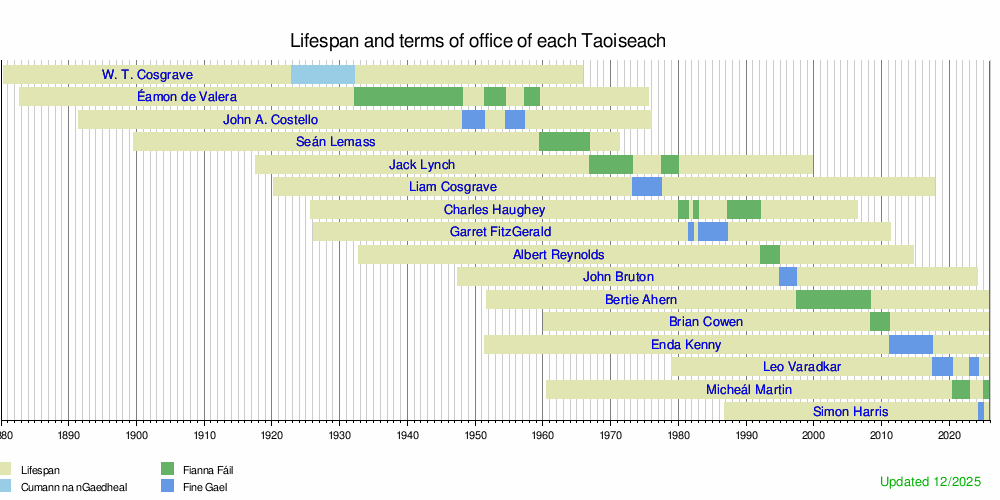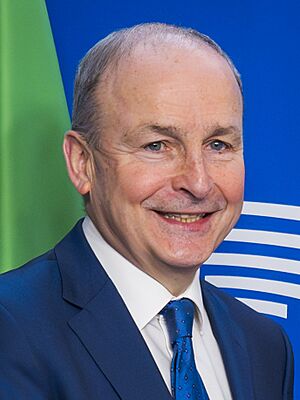Taoiseach facts for kids
Quick facts for kids Taoiseach |
|
|---|---|
 |
|
|
|
| Style | Irish: A Thaoisigh |
| Member of |
|
| Reports to | Oireachtas |
| Residence | None |
| Seat | Government Buildings, Merrion Street, Dublin, Ireland |
| Nominator | Dáil Éireann |
| Appointer | President of Ireland |
| Term length | While commanding the confidence of the majority of Dáil Éireann. No term limits are imposed on the office. |
| Constituting instrument | Article 13, Constitution of Ireland |
| Precursor | President of the Executive Council |
| Formation | 29 December 1937 |
| First holder | Éamon de Valera |
| Deputy | Tánaiste |
| Salary | €248,773 annually (2025) (including €115,953 TD salary) |
| Website | Department of the Taoiseach |
The Taoiseach (pronounced TEE-shukh) is the leader of the government in Ireland. You can think of the Taoiseach as Ireland's prime minister. The President of Ireland officially appoints the Taoiseach. However, the Taoiseach is first chosen by Dáil Éireann, which is the main part of Ireland's parliament, called the Oireachtas. To stay in the job, the Taoiseach must always have the support of most members in the Dáil.
The word taoiseach comes from the Irish language. It means "chief" or "leader." This title was chosen for Ireland's head of government in the 1937 Constitution of Ireland. It is the official title in both English and Irish. For leaders of other countries, the Irish word príomh-aire (pronounced preev-AIR-uh) is used instead. Sometimes, you might hear "an Taoiseach" in English, which means "the Taoiseach."
The current Taoiseach is Micheál Martin. He is a TD, which means a member of the Dáil. He is also the leader of the Fianna Fáil political party. He became Taoiseach on 23 January 2025. This happened after the 2024 Irish general election and an agreement between Fianna Fáil, Fine Gael, and some independent politicians.
Contents
How the Taoiseach is Chosen
The Constitution of Ireland explains how the Taoiseach is picked. First, the Dáil Éireann votes. The person who gets more than half of the votes from the members of the Dáil is nominated. Then, the President of Ireland formally appoints this person. The President must appoint whoever the Dáil chooses. Because of this, people sometimes say the Taoiseach is "elected" by the Dáil.
If the Taoiseach loses the support of most members in the Dáil, they don't automatically leave office. Instead, they must either resign or ask the President to dissolve the Dáil. If the Dáil is dissolved, it means new elections will be held. If the President refuses to dissolve the Dáil, the Taoiseach must resign. So far, no President has ever refused this request.
The Taoiseach also chooses the other members of the Government, who are like ministers. The Dáil must agree to these choices, and then the President appoints them. The Taoiseach can also ask the President to remove ministers from their jobs. The President must follow this advice. The Taoiseach also helps choose eleven members of the Seanad, which is the upper house of parliament.
The Department of the Taoiseach is a special government office. It helps and advises the Taoiseach with all their duties. The Taoiseach also has help from other ministers who work in this department.
Salary and Home
As of 1 March 2025, the Taoiseach's salary is €248,773 per year. This amount includes their salary as a TD. In the past, the Taoiseach's salary has changed. For example, it was cut in 2011 and again in 2013.
There is no official home for the Taoiseach. Sometimes, people thought that Steward's Lodge at Farmleigh might become the official residence. This house was renovated in 2005. Some past Taoisigh, like Brian Cowen, Enda Kenny, and Leo Varadkar, used it sometimes. They paid a small fee to use the house.
Musical Salute
When the Taoiseach arrives at official state events, army bands play a special musical salute. This tune is called "Mór Chluana" (which means "More of Cloyne"). It is a traditional Irish air. Sometimes, people mistakenly call it "Amhrán Dóchais" ("Song of Hope").
History of the Title
Origins and Meaning
The words Taoiseach and Tánaiste (which means deputy prime minister) are both very old Irish words. The Constitution says the Taoiseach is "the head of the Government or Prime Minister." The word literally means "chieftain" or "leader." When Éamon de Valera introduced the title in 1937, some people noted that the meaning "leader" was similar to titles used by other leaders around the world at that time. The word Tánaiste comes from an old Gaelic system called tanistry. In this system, a leader would choose their successor while they were still alive.
The word tòiseach in Scottish Gaelic also means 'clan chief.' Both words have similar meanings in the Gaelic languages of Scotland and Ireland. The Welsh word tywysog (meaning 'prince') also has a similar origin. Experts believe all these words come from an even older language, meaning 'chieftain' or 'leader.'
The plural of taoiseach is taoisigh.
Debate About the Title
In 1937, when the new Constitution was being discussed, some politicians debated the title "Taoiseach." Frank MacDermot, an opposition politician, suggested using "Prime Minister" in the English version of the Constitution. He wanted to keep "Taoiseach" only in the Irish text. He felt that most people would mispronounce "Taoiseach" in English. He also thought using an Irish word might make people in Northern Ireland feel less connected.
However, Éamon de Valera, who was leading the government at the time, did not agree. He said the word "Taoiseach" meant "chieftain" or "Captain" and did not need to be changed. The idea to change the title was voted down. So, "Taoiseach" became the official title after the people voted to approve the Constitution.
The Modern Role
The job of Taoiseach, as we know it today, was created by the 1937 Constitution of Ireland. It is the most powerful political role in Ireland. Before 1937, the leader of the government was called the President of the Executive Council. This was during the time of the Irish Free State (1922–1937).
The Taoiseach's role is much stronger than the old President of the Executive Council. For example, the old leader could not fire a minister on their own. The whole government had to be dissolved and reformed. Also, the old leader could not ask the Governor-General to dissolve the Dáil by themselves.
In contrast, the Taoiseach can advise the President to dismiss ministers. They can also ask the President to dissolve Parliament. The President almost always has to follow this advice. This means the Taoiseach has a lot of power. In Ireland, the Constitution clearly states that the government, led by the Taoiseach, holds the main executive power.
Usually, when there are governments made up of several parties (coalitions), the Taoiseach is the leader of the biggest party in that group. One time this was different was with John A. Costello. He was not the leader of his party, but other parties agreed he should lead the government.
After the 2020 Irish general election, Fianna Fáil and Fine Gael formed a government together for the first time. They decided to share the role of Taoiseach. Micheál Martin was Taoiseach first, and then he became Tánaiste (deputy prime minister) under Leo Varadkar of Fine Gael. This rotation continued after the 2024 Irish general election.
List of Taoisigh
Before the 1937 Constitution, the head of government was the President of the Executive Council. W. T. Cosgrave held this job from 1922 to 1932. Éamon de Valera held it from 1932 to 1937. When we count the Taoisigh, we usually include Cosgrave. So, Micheál Martin is considered the 15th Taoiseach.
President of the Executive Council |
||||||||||
| No. | Portrait | Name (Birth–Death) Constituency |
Term of office | Party | Exec. Council Composition |
Vice President | Dáil (elected) |
|||
|---|---|---|---|---|---|---|---|---|---|---|
| 1 |
|
W. T. Cosgrave (1880–1965) TD for Carlow–Kilkenny until 1927 TD for Cork Borough from 1927 |
6 December 1922 |
9 March 1932 |
Sinn Féin (Pro-Treaty) |
1st | SF (PT) (minority) | Kevin O'Higgins | 3 (1922) | |
| Cumann na nGaedheal | 2nd | CnG (minority) | 4 (1923) | |||||||
| 3rd | Ernest Blythe | 5 (Jun.1927) | ||||||||
| 4th | 6 (Sep.1927) | |||||||||
| 5th | ||||||||||
| 2 |
|
Éamon de Valera (1882–1975) TD for Clare |
9 March 1932 |
29 December 1937 |
Fianna Fáil | 6th | FF (minority) | Seán T. O'Kelly | 7 (1932) | |
| 7th | 8 (1933) | |||||||||
| 8th | 9 (1937) | |||||||||
Taoiseach |
||||||||||
| No. | Portrait | Name (Birth–Death) Constituency |
Term of office | Party | Government Composition |
Tánaiste | Dáil (elected) |
|||
| (2) |
|
Éamon de Valera (1882–1975) TD for Clare |
29 December 1937 |
18 February 1948 |
Fianna Fáil | 1st | FF (minority) | Seán T. O'Kelly | 9 ( ···· ) | |
| 2nd | FF | 10 (1938) | ||||||||
| 3rd | FF (minority) | 11 (1943) | ||||||||
| 4th | FF | Seán Lemass | 12 (1944) | |||||||
| 3 |
|
John A. Costello (1891–1976) TD for Dublin South-East |
18 February 1948 |
13 June 1951 |
Fine Gael | 5th | FG–Lab–CnP–CnT–NL–Ind | William Norton | 13 (1948) | |
| (2) |
|
Éamon de Valera (1882–1975) TD for Clare |
13 June 1951 |
2 June 1954 |
Fianna Fáil | 6th | FF (minority) | Seán Lemass | 14 (1951) | |
| (3) |
|
John A. Costello (1891–1976) TD for Dublin South-East |
2 June 1954 |
20 March 1957 |
Fine Gael | 7th | FG–Lab–CnT | William Norton | 15 (1954) | |
| (2) |
|
Éamon de Valera (1882–1975) TD for Clare |
20 March 1957 |
23 June 1959 |
Fianna Fáil | 8th | FF | Seán Lemass | 16 (1957) | |
| 4 |
|
Seán Lemass (1899–1971) TD for Dublin South-Central |
23 June 1959 |
10 November 1966 |
Fianna Fáil | 9th | FF | Seán MacEntee | ||
| 10th | FF (minority) | 17 (1961) | ||||||||
| 11th | FF | Frank Aiken | 18 (1965) | |||||||
| 5 |
|
Jack Lynch (1917–1999) TD for Cork Borough until 1969 TD for Cork City North-West from 1969 |
10 November 1966 |
14 March 1973 |
Fianna Fáil | 12th | FF | |||
| 13th | FF | Erskine H. Childers | 19 (1969) | |||||||
| 6 |
|
Liam Cosgrave (1920–2017) TD for Dún Laoghaire and Rathdown |
14 March 1973 |
5 July 1977 |
Fine Gael | 14th | FG–Lab | Brendan Corish | 20 (1973) | |
| (5) |
|
Jack Lynch (1917–1999) TD for Cork City |
5 July 1977 |
11 December 1979 |
Fianna Fáil | 15th | FF | George Colley | 21 (1977) | |
| 7 |
|
Charles Haughey (1925–2006) TD for Dublin Artane |
11 December 1979 |
30 June 1981 |
Fianna Fáil | 16th | FF | |||
| 8 |
|
Garret FitzGerald (1926–2011) TD for Dublin South-East |
30 June 1981 |
9 March 1982 |
Fine Gael | 17th | FG–Lab (minority) | Michael O'Leary | 22 (1981) | |
| (7) |
|
Charles Haughey (1925–2006) TD for Dublin North-Central |
9 March 1982 |
14 December 1982 |
Fianna Fáil | 18th | FF (minority) | Ray MacSharry | 23 (Feb.1982) | |
| (8) |
|
Garret FitzGerald (1926–2011) TD for Dublin South-East |
14 December 1982 |
10 March 1987 |
Fine Gael | 19th | FG–Lab FG (minority) from Jan 1987 |
Dick Spring | 24 (Nov.1982) | |
| Peter Barry | ||||||||||
| (7) |
|
Charles Haughey (1925–2006) TD for Dublin North-Central |
10 March 1987 |
11 February 1992 |
Fianna Fáil | 20th | FF (minority) | Brian Lenihan | 25 (1987) | |
| 21st | FF–PD | 26 (1989) | ||||||||
| John Wilson | ||||||||||
| 9 |
|
Albert Reynolds (1932–2014) TD for Longford–Roscommon |
11 February 1992 |
15 December 1994 |
Fianna Fáil | 22nd | FF–PD FF (minority) from Nov 1992 |
|||
| 23rd | FF–Lab FF (minority) from Nov 1994 |
Dick Spring | 27 (1992) | |||||||
| Bertie Ahern | ||||||||||
| 10 |
|
John Bruton (1947–2024) TD for Meath |
15 December 1994 |
26 June 1997 |
Fine Gael | 24th | FG–Lab–DL | Dick Spring | ||
| 11 |
|
Bertie Ahern (b. 1951) TD for Dublin Central |
26 June 1997 |
7 May 2008 |
Fianna Fáil | 25th | FF–PD (minority) | Mary Harney | 28 (1997) | |
| 26th | FF–PD | 29 (2002) | ||||||||
| Michael McDowell | ||||||||||
| 27th | FF–Green–PD | Brian Cowen | 30 (2007) | |||||||
| 12 |
|
Brian Cowen (b. 1960) TD for Laois–Offaly |
7 May 2008 |
9 March 2011 |
Fianna Fáil | 28th | FF–Green–PD FF–Green–Ind from Nov 2009 FF (minority) from Jan 2011 |
Mary Coughlan | ||
| 13 |
|
Enda Kenny (b. 1951) TD for Mayo |
9 March 2011 |
14 June 2017 |
Fine Gael | 29th | FG–Lab | Eamon Gilmore | 31 (2011) | |
| Joan Burton | ||||||||||
| 30th | FG–Ind (minority) | Frances Fitzgerald | 32 (2016) | |||||||
| 14 |
|
Leo Varadkar (b. 1979) TD for Dublin West |
14 June 2017 |
27 June 2020 |
Fine Gael | 31st | FG–Ind (minority) | |||
| Simon Coveney | ||||||||||
| 15 |
|
Micheál Martin (b. 1960) TD for Cork South-Central |
27 June 2020 |
17 December 2022 |
Fianna Fáil | 32th | FF–FG–Green | Leo Varadkar | 33 (2020) | |
| (14) |
|
Leo Varadkar (b. 1979) TD for Dublin West |
17 December 2022 |
9 April 2024 |
Fine Gael | 33rd | FG–FF–Green | Micheál Martin | ||
| 16 |
|
Simon Harris (b. 1986) TD for Wicklow |
9 April 2024 |
23 January 2025 |
Fine Gael | 34th | FG–FF–Green | |||
| (15) |
|
Micheál Martin (b. 1960) TD for Cork South-Central |
23 January 2025 |
Incumbent | Fianna Fáil | 35th | FF–FG–Ind | Simon Harris | 34 (2024) | |
Timeline of Taoisigh

See also
 In Spanish: Taoiseach para niños
In Spanish: Taoiseach para niños
- Politics of the Republic of Ireland
- Records of Irish heads of government since 1922
- Irish heads of government since 1919



















